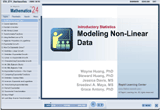Modeling Non-linear Data
| Rapid Study Kit for "Title": |
| Flash Movie |
Flash Game |
Flash Card |
| Core Concept Tutorial |
Problem Solving Drill |
Review Cheat Sheet |
 |
 |
 |
|
| "Title" Tutorial Summary : |
This tutorial describes the way to model non-linear data. We will identify exponential and power functions. Through which we can transform exponential and power functions into linear functions. And then by using properties of logarithms, we can create a model for non-linear data.
We will also discuss the relationship between errors and residuals. Then we will also introduce studentized residual for further applications.
|
| Tutorial Features: |
Specific Tutorial Features:
- Studentized residuals are used because the variances of the residuals differ, even though the variances of the true errors are all equal to each other.
- Least-squares regression techinques is used to minimize residual between the data points and the curve.
Series Features:
- Concept map showing inter-connections of new concepts in this tutorial and those previously introduced.
- Definition slides introduce terms as they are needed.
- Visual representation of concepts
- Animated examples—worked out step by step
- A concise summary is given at the conclusion of the tutorial.
|
| "Title" Topic List: |
- Linear growth
- Exponential growth
- Common Ratio
- Algebraic Properties of Logarithms
- Studentized Residual
|
See all 24 lessons in Introductory Statistics, including concept tutorials, problem drills and cheat sheets:
Teach Yourself Introductory Statistics Visually in 24 Hours |



